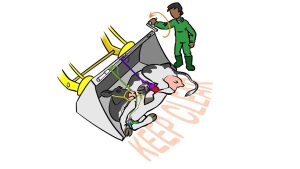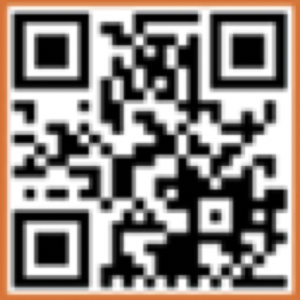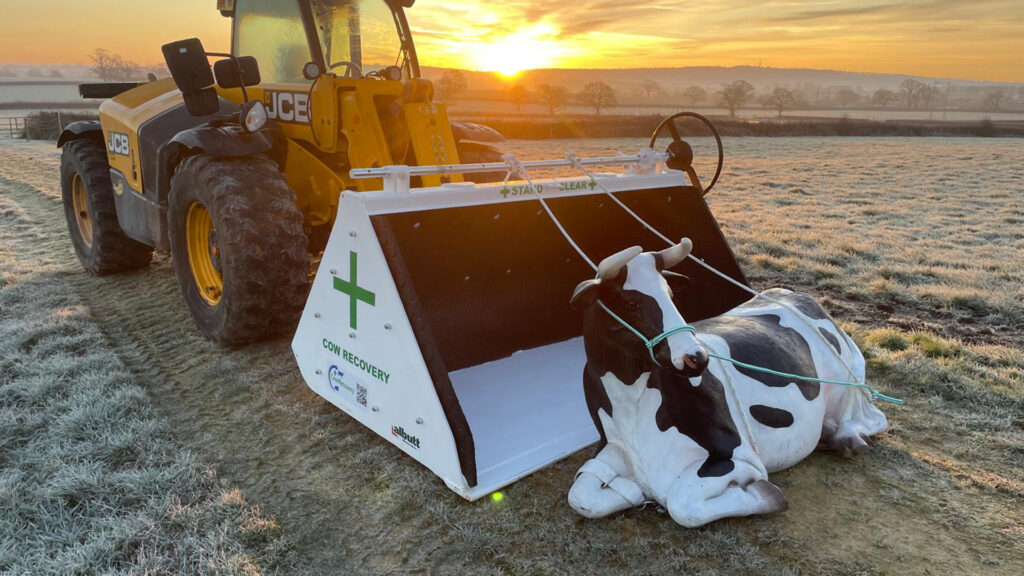James Yeatman, Dairy Farmer and Managing Director of CowRecovery, introduces the CowRecovery system designed to offer a sustainable, cost-effective, and safer solution to deal with down cows.
On every dairy farm, there are moments that test even the most experienced stockperson. One of the most difficult is the issue of a cow unable to stand. It’s a challenge that brings together animal welfare, labour demands, financial pressure, and emotional strain. And yet, despite the seriousness of the issue, many farms still rely on makeshift, outdated, or dangerous methods to respond.
The CowRecovery system was born from years of hands-on experience, frustration, and the deep belief that we can – and must – do better. This article explains the origins, purpose, and hopeful impact of the CowRecovery system, and how it represents a step towards a change in the way we manage one of dairy farming’s most demanding problems.
The down cow problem
Down cows, whether caused by illness or injury, pose a major challenge across the dairy industry. Their presence creates serious animal welfare concerns, substantial financial losses, and reputational risks for farms. This is not a problem exclusive to certain types of operations: whether large or small, intensive or extensive, and regardless of management standards, every dairy farm will inevitably encounter down cows at some point.
A variety of methods currently exist to move these animals, but most are labour-intensive, hazardous, and frequently inadequate. The most common approach involves using a standard tractor bucket. However, these are typically poorly sized for the cow, feature sharp edges that risk cuts or abrasions, often requiring antibiotic treatment, and require significant physical effort from multiple people, exposing both cow and handler to serious injury.
Nets are sometimes used as an alternative, but they still demand manual rolling of the cow, which remains risky and inefficient. In the absence of purpose-built tools, some farmers resort to makeshift solutions such as tarpaulins or metal sheeting attached to not-for-purpose farm machinery. These options tend to be awkward, unreliable, and pose further safety and welfare concerns.
All farmers have experienced or know of injuries resulting from these conventional methods. Personal knowledge of injuries among colleagues range from minor cuts and bruises to long-term back problems and, in some extreme cases, even permanent injuries – such as the loss of a big toe. It is our hope that the CowRecovery system, with its focus on safety, efficiency, and animal welfare, will mark the end of preventable injuries and usher in a new standard for handling down cows.
The origins of the CowRecovery system
My journey with down cows began at the age of 13, assisting with difficult calvings in my family’s pedigree Charolais herd. For three decades, I pursued the goal of breeding easy-calving Charolais, but eventually came to the conclusion that the approach was unsustainable. I transitioned instead to easy-calving sexed-semen alongside Angus to reduce trauma and complications.
Throughout those 30 years, inevitably I gained extensive experience in the recovery and handling of down cows. Determined to turn these hard-earned lessons into something positive, I started the CowRecovery project. My aim was to create a suitable piece of equipment and ultimately share the knowledge I had accumulated and make it accessible to others across the dairy industry – especially young or inexperienced farmers – so they might avoid the same pitfalls I had encountered. The final trigger came after watching a BBC Panorama broadcast showing footage of a down cow being moved with a hip hoist – a method that, while common on some farms, causes both obvious and unseen damage to the animal and is damaging to public perception of the dairy sector.
Initially, I developed a simple technique that allowed movement of a recumbent cow alone, but knew it needed refinement. With the help of two local engineers, Chris Cox and Edwin Parrott, a working prototype was fabricated. This led to a collaboration with Synergy Farm Health and Albutt Attachments, aiming not only to improve the system’s safety and consistency but also to ensure it looked professional and appropriate for modern farm practice. If we want public understanding and professional standards to rise, our practices must reflect that.
Led by Rachel Hayton of Synergy Farm Health, the system was trialled over ten months across 15 farms with more than 10,000 cows. With assistance from an Innovate UK grant, the CowRecovery system has evolved into a reliable, repeatable method, complete with a dedicated loading technique and training programme. The result is a safer, more humane, and more professional standard for dealing with one of the most difficult challenges in dairy farming.
What is the CowRecovery system?
The CowRecovery system is designed to safely and efficiently move a down cow to a designated recovery pen – ideally one bedded with deep straw or sand to provide comfort and reduce pressure injuries.
At the heart of the system is a hand-operated reeling mechanism that allows for controlled, gradual loading. This manual approach is deliberate: using hydraulic or mechanical force on a compromised animal has the potential for additional harm and stress due to the less forgiving nature of mechanical force. By contrast, the CowRecovery system enables safe, precise handling with human force that can move an animal in a responsive manner.
The unit itself features a smooth, rounded front edge and is lined with thick rubber padding, significantly reducing the likelihood of cuts or impact injuries during loading. To further support safe handling, the system is equipped with bespoke wide leg straps, ropes, clips, and a halter, all tailored specifically for this system. These accessories are stored neatly in an integrated carry box on the machine, ensuring everything needed is always at hand – no more time wasted searching for scattered equipment.
Beyond its functional design, the CowRecovery system carries a distinct visual identity that communicates professionalism and compassion. Its clear, branded appearance is visible from a distance, sending a strong signal to farm staff – and importantly, to the public – that this is a purpose-built, welfare-focused tool. It represents a shift toward more humane, responsible, and visibly accountable livestock care.
Who is the CowRecovery system for?
Every dairy farm – large or small – will, at some point, be faced with a down cow. On larger farms, these incidents may be more frequent simply due to herd size. On smaller farms, they can be more difficult to manage due to limited labour. But no matter the circumstances, when a cow goes down, you need more than good intentions – you need a clear, safe, and well-practised plan.
The CowRecovery system is for any farm that wants to approach this challenge with professionalism, compassion, and confidence. We believe a down cow deserves the same quality of care that a human might receive from an emergency response team. Put yourself in the cow’s position. As an injured person, you’d expect prompt, respectful, and skilled assistance – not to be dragged or manhandled in a way that adds pain or worsens your condition. Why should it be any different for animals in our care?
With a CowRecovery system in place, down cows can be moved quickly and safely into a dedicated recovery pen. This speed is more than a convenience – it’s a welfare imperative. Once a cow is left lying on a hard surface, irreversible damage can begin within 1-2 hours, often sealing the fate of an animal that might otherwise recover with prompt, proper treatment.

The system is designed to work with just two people, or even a single handler in an emergency – a crucial feature for farms with stretched staffing.
One farmer who recently adopted the CowRecovery system explained: “We used to have to stop milking to get enough people to help load the animal. That alone would cost us more than half an hour. Now, we can act immediately without disrupting the rest of the farm.”
Whether you’re a family-run farm or a high-throughput commercial unit, the CowRecovery system empowers you to act fast, act safely, and act with dignity – for both the cow and the people involved. It’s not just a tool, it’s a commitment to higher welfare, better outcomes, and a more professional standard of care across the industry.
Beyond the CowRecovery device: Changing mindsets and raising standards
CowRecovery is about more than just equipment, it’s about transforming the way the industry thinks about and responds to down cows. Our collaboration with Synergy Farm Health has led to the development of a comprehensive training programme, designed to be delivered alongside the system. The goal is for every dairy farm in the UK to not only own a CowRecovery system, but also to know exactly how and when to use it.
We believe that true progress comes from awareness and accountability. That’s why we advocate for the routine recording of down cow incidents. By tracking when and where these events occur, farms can build heat maps of high-risk areas and take steps to reduce future cases. This data-led approach has already made a significant impact on our own farm – highlighting underlying issues such as slippery floors, injuries linked to feeding routines, and stress caused by group changes.
Recording down cow events has also helped us identify and mitigate the causes of metabolic disorders, as well as flag patterns in conditions like toxic mastitis and dystocia (difficult calvings). In short, it turns an emergency response into a continuous cycle of learning and improvement.
Our vision is to professionalise the industry’s response to down cows. Not just for the sake of public perception or regulatory compliance, but because it’s the right thing to do – for the animals, for the staff, and for the future of dairy farming. We believe that every farm should be equipped and every stockperson should be trained so that, when a cow goes down, there is no panic – only a calm, capable, and compassionate response.
In a global market, animal welfare can be our competitive edge. We should be proud to lead by example and set a standard that others aspire to. The CowRecovery System – alongside the culture of responsibility and professionalism it promotes – should become the new normal.
Sustainability
While researching the use of the green cross symbol – now widely recognised in animal care – I was amused to discover that it was first adopted in 1994 by Mikhail Gorbachev as part of his early sustainability movement. That unexpected connection struck a chord, because at its core, CowRecovery is a sustainability project – not just in the environmental sense, but across animal welfare, farm economics, and the long-term viability of the dairy industry.
We often describe the CowRecovery system as the sustainable solution to down cow management, and for good reason. Every cow saved from an otherwise preventable death represents more than just an individual animal spared – it’s a reduction in the waste of resources. A cow that recovers and returns to production reduces the methane and carbon emitted per litre of milk produced, and eventually per kilogram of beef. Saving lives also means lower replacement rates, less financial loss, and a smaller carbon footprint across the board.
But sustainability isn’t just about carbon. It’s about creating an industry that can last. By raising welfare standards, reducing reputational risks, and promoting professional, proactive care, CowRecovery contributes to a more trusted and resilient future for dairy farming. One where the public sees responsible, skilled stockmanship and where the next generation of farmers inherits an industry that’s proud, progressive, and prepared.
Public perception
Today’s consumers expect more from the food they buy. They want to know their milk and meat come from farms that prioritise animal welfare, environmental responsibility, and transparency – and they want it at an affordable price. At first glance, these goals can seem in conflict. But we believe the CowRecovery system helps bridge that gap, delivering both high welfare and cost efficiency.
Poorly managed down cows not only lead to suffering – they also create economic waste and damage public trust. A single incident handled badly can tarnish a farm’s reputation, and by extension, the reputation of the wider dairy industry. By contrast, a well-managed response to a down cow demonstrates compassion, professionalism, and care – values the public increasingly expects to see reflected in the food system.
The CowRecovery system protects our public licence to farm. It is a highly visible, purpose-built solution that signals to anyone – visitors, customers, auditors, or passers-by – that this is a farm that takes animal welfare seriously. It replaces makeshift methods with something that is not only safer, but clearly designed with care and intention.
In a world where farming is often under the spotlight, tangible welfare improvements like CowRecovery are essential. They show that we are not just reacting to criticism, but proactively working to improve – and that we value the trust placed in us by the public.
Feedback so far
Following our launch at DairyTech UK, the CowRecovery system sparked plenty of conversation – and, as with any innovation, a mix of opinions. A handful of critics, often less familiar with the realities of down cow management, questioned whether the system was ‘over the top’. But those concerns have been overwhelmingly outweighed – and directly rebutted – by the positive experiences of farmers who’ve actually used it on the ground.
The feedback from current users has been clear, consistent, and enthusiastic:
“It’s a no-brainer – every farm should have one.”
“Fantastic – just wish it had been done 30 years ago.”
“It’s great having it on the farm. It sparks a lot of conversation and interest.”
These voices speak volumes. They come from farmers who know the stress, danger, and heartache of dealing with down cows the old way – and who now see a safer, dignified and professional alternative in action.
The CowRecovery system isn’t just a piece of equipment – it’s a cultural shift, and like all change, it takes time. But with every positive review, every life saved, and every injury avoided, it becomes clearer that this isn’t ‘over the top’ – it’s what the industry needs.
Where to purchase?
You can purchase the CowRecovery System directly from us. All we need to know is the required width – 7’ or 7’6” – and the type of loader brackets you need. The total cost is £4,995, which includes 12 months warranty, all ropes, leg straps, halter, training and delivery anywhere on the UK mainland. To put it into perspective: saving just one or two early lactation cows can easily offset the cost of the system – making it not just a welfare improvement, but a smart financial decision. For further information visit www.cowrecovery.com. Please contact james@cowrecovery.com or call +44 07970 426 186 for enquiries.
A final message
The positive feedback from herdsmen, farmers, and vets has been overwhelmingly encouraging. I hope farmers embrace CowRecovery as an opportunity to make a meaningful difference to the industry we all care about.
We believe that the CowRecovery System will help reduce antibiotic use, allow prompt movement, improve recovery rates, lower mortality, and protect both worker safety and public confidence. Every recovered cow is a life saved, a cost avoided, and a step toward a more sustainable dairy industry.
Please note, this article will also appear in the 22nd edition of our quarterly publication.
Source link

